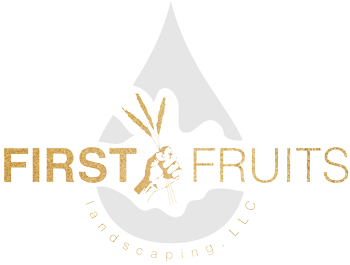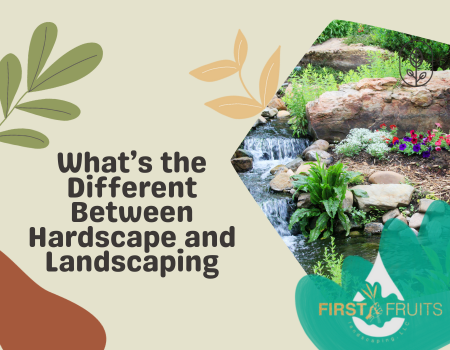Your outdoor space is a canvas waiting to be transformed into a beautiful and functional oasis. Your yard is an extension of your home which is why when designing and creating your dream yard, it’s important to understand the key components that will shape its look and feel. Two fundamental elements that play a crucial role in outdoor design are hardscape and landscape. When thoughtfully combined, these elements can help you create a perfect space for relaxation, entertainment, and enjoying the great outdoors with friends and family.
Understanding the Differences Between Hardscape and Landscaping
What Is Hardscape?
Hardscape refers to the solid, non-living features in your outdoor space. These elements often define the use of a space and provide a framework for the surrounding landscaping (living, natural elements). Hardscape elements can range from functional necessities like driveways and pathways to aesthetic enhancements like patios and fencing. They are the backbone of your outdoor area, ensuring it serves your needs and functions efficiently.
Common Hardscape Elements
- Stone Retaining Walls: These walls are not only visually appealing but also serve a practical purpose. They can create planting areas or convert a sloped yard into flat, usable space. Stone retaining walls offer a natural and timeless aesthetic.
- Concrete Patios: Concrete patios are a classic choice for outdoor flooring. They are low-maintenance, durable, and versatile, making them ideal for a variety of outdoor activities and gatherings.
- Brick Patios: If you’re looking for a more upscale and natural appearance than concrete, brick patios are an excellent choice. They exude charm and warmth, making them perfect for traditional or rustic settings.
- Flagstone Patios: For a cost-effective option that provides the beauty of natural stone, consider flagstone patios. They offer a unique, earthy look and are a great choice for outdoor flooring.
- Tile Patios: Transform a plain concrete patio into an elegant outdoor space by adding tile. Tile patios come in a wide range of styles and colors, allowing you to create a customized look.
- Stone Walkways: Stone walkways add a touch of sophistication to your garden paths. They are both functional and visually pleasing, guiding visitors through your landscape.
- Gravel Paths: Gravel paths are a softer alternative to solid materials like brick, concrete, or stone. They provide a more rustic and informal feel to your landscape.
- Stone Landscape Steps: If your outdoor space has elevation changes, stone landscape steps can be both practical and visually appealing. Heavy stone slabs are used to create stunning outdoor steps.
- Metal Fences: Modern hardscape often includes coated steel fences, which provide a clean and contemporary look. However, traditional iron fences remain an option for those seeking a timeless appearance.
- Wooden Fences: Wood is one of the most versatile hardscaping materials. Wooden fences not only offer privacy and security but also contribute to the overall aesthetic of your outdoor space.
- Wooden Decks: Just like patios, wooden decks are considered hardscaping. They provide an elevated platform for various outdoor activities and can be customized to match your style.
- Wooden Arbors or Gazebos: These structures enhance your landscape while providing shade and a touch of elegance. They serve as focal points and can be adorned with climbing plants.
- Pergolas: Pergolas are arbor-like structures that can be attached to your house or another building. They offer partial shade and can define outdoor living spaces.
Understanding Landscaping
On the other hand, landscaping primarily involves living elements—trees, ground cover, flowering plants, and more. It’s about enhancing the natural beauty of your outdoor space and creating an environment that harmonizes with the hardscape features. Landscaping can range from simple flower beds and shrubs to intricate garden designs or even the inclusion of unique elements like fire pits or water features.
Common Landscape Elements
- Plantings: Trees, shrubs, flowers, and other plants are the heart of landscaping. They add color, texture, and life to your outdoor space.
- Paths: Pathways winding through your landscape are often a blend of hardscape and landscape. They guide visitors and create a natural flow within the space.
- Fences: While fences can be a hardscape element, they can also be intertwined with plantings to create natural fencing, like a hedge.
- Patios: Patios can be considered a hardscape element, but when surrounded by carefully selected plantings, they become an integral part of the landscape.
- Water Features: Ponds, fountains, and waterfalls add a serene and refreshing touch to your landscape.
When creating the perfect outdoor space, understanding the distinction between hardscape and landscape is essential. Hardscape provides structure, functionality, and aesthetic appeal, while landscape brings life, color, and natural beauty to your yard and when done correctly, these elements come together to shape an outdoor living space that you’ll love.
Whether you’re looking to design a tranquil garden retreat, an outdoor entertainment hub, or a functional family space, blending hardscape and landscape elements will truly transform your yard. So, as you embark on your outdoor design project, work closely with your landscaper or outdoor contractor to strike the perfect balance, and soon, you’ll be enjoying your very own outdoor paradise.

